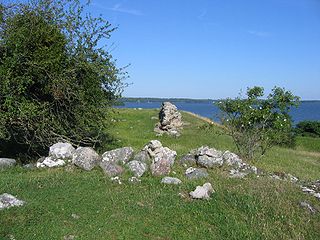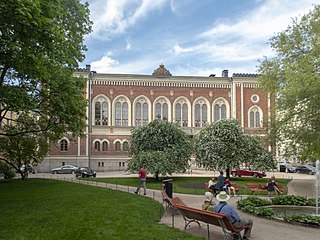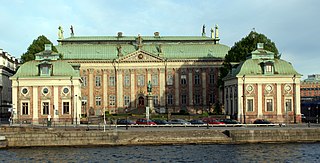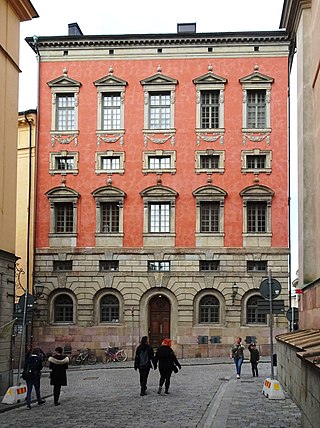
The House of Nobility (Swedish : Riddarhuset) in Stockholm, Sweden, is a corporation and a building that maintains records and acts as an interest group on behalf of the Swedish nobility.

The House of Nobility (Swedish : Riddarhuset) in Stockholm, Sweden, is a corporation and a building that maintains records and acts as an interest group on behalf of the Swedish nobility.
The name is literally translated as House of Knights, as the knights (Swedish : riddare ) belong to the higher ranks of the Swedish nobility, sometimes also together with titles as count (Swedish : Greve) and baron (Swedish : friherre ). All esquires are also represented in the corporation (most of the families are so called untitled nobility, Swedish : obetitlad adel). This is a tradition from the Middle Ages when Sweden during the Kalmar Union only had one knight: Sten Sture.
Between the 17th and the 19th century the House of Nobility was a chamber in the Riksdag of the Estates.
In the 18th century, the building was often used for public concerts. From 1731, public concerts were performed here by Kungliga Hovkapellet. Elisabeth Olin is believed to have debuted here in the 1750s, and foreign artists performed such as Elisabetta Almerighi, Giovanni Ansani (1772) and Rosa Scarlatti.
In 1866, the Parliament of the Estates was replaced by the new Parliament of Sweden. From then on, the House of Nobility served as a quasi-official representative body for the Swedish nobility, regulated by the Swedish government. Since 2003, it has been a private institution which maintains records and acts as an interest group on behalf of the Swedish nobility, its main purpose being to maintain old traditions and culture.

The Riddarhuset is also the name of the building maintained by the corporation in Stockholm old town. The French-born architect Simon de la Vallée started the planning of the building, but was killed by a Swedish nobleman in 1642. The plans were eventually finished by his son, Jean de la Vallée, in 1660.
The south end of the building carries the Latin inscription CLARIS MAIORUM EXEMPLIS, after the clear example of the forefathers, and holds a statue of Gustav Vasa, the king of Sweden 1523-1560. North of the building is a park in which is a statue of Axel Oxenstierna.
The architecture of the old main library in Turku, Finland, was influenced by the Swedish House of Nobility.

Axel Gustafsson Oxenstierna of Södermöre, Count of Södermöre, was a Swedish statesman. He became a member of the Swedish Privy Council in 1609 and served as Lord High Chancellor of Sweden from 1612 until his death. He was a confidant of King Gustavus Adolphus and then Queen Christina, of whom he was at first regent.

Riksdag of the Estates was the name used for the Estates of Sweden when they were assembled. Until its dissolution in 1866, the institution was the highest authority in Sweden next to the King. It was a Diet made up of the Four Estates, which historically were the lines of division in Swedish society:

Oxenstierna is a Swedish noble family, originally from Småland in southern Sweden, and is part of the Swedish uradel, the ancient nobility. The Oxenstierna family held vast estates in Södermanland and Uppland during the late Middle Ages and Renaissance. In the 15th century, the family at times held the position of Regent of Sweden during the turbulent civil wars of the Kalmar Union. The family began to adopt its armorial designation of Oxenstierna as a personal surname towards the end of the 16th century. In the case of earlier members of the family, the surname has been retroactively applied by historians.

Gamla stan, until 1980 officially Staden mellan broarna, is the old town of Stockholm, Sweden. Gamla stan consists primarily of the island Stadsholmen. Officially, but not colloquially, Gamla stan includes the surrounding islets Riddarholmen, Helgeandsholmen and Strömsborg. It has a population of approximately 3,000.

The Swedish nobility has historically been a legally and/or socially privileged class in Sweden, and part of the so-called frälse. The archaic term for nobility, frälse, also included the clergy, a classification defined by tax exemptions and representation in the diet. Today the nobility does not maintain its former legal privileges although family names, titles and coats of arms are still protected. The Swedish nobility consists of both "introduced" and "unintroduced" nobility, where the latter has not been formally "introduced" at the House of Nobility (Riddarhuset). The House of Nobility still maintains a fee for male members over the age of 18 for upkeep on pertinent buildings in Stockholm.

The Bonde Palace is a palace in Gamla stan, the old town in central Stockholm, Sweden. Located between the House of Knights (Riddarhuset) and the Chancellery House (Kanslihuset), it is, arguably, the most prominent monument of the era of the Swedish Empire (1611–1718), originally designed by Nicodemus Tessin the Elder and Jean De la Vallée in 1662-1667 as the private residence of the Lord High Treasurer Gustaf Bonde (1620–1667) it still bears his name, while it accommodated the Stockholm Court House from the 18th century and since 1949 houses the Swedish Supreme Court. On the south side of the building is the street Myntgatan and the square Riddarhustorget, while the alleys Riddarhusgränd and Rådhusgränd are passing on its western and eastern sides.

Adlercreutz is the surname of a Swedish and Finnish noble family.

The House of Nobility either refers to the institution of the Finnish nobility or the palace of the noble estate. The Finnish nobility was until 1906 the first of the four estates of the realm.
The Finnish nobility was historically a privileged class in Finland, deriving from its period as part of Sweden and the Russian Empire. Noble families and their descendants are still a part of Finnish republican society, but except for the titles themselves, no longer retain any specific or granted privileges. A majority of Finnish nobles have traditionally been Swedish-speakers using their titles mostly in Swedish. The Finnish nobility today has some 6,000 male and female members.

Horn is a Swedish noble family from Finland, known since the 14th century.

Högvaktsterrassen is a street in Gamla stan, the old town in central Stockholm, Sweden passing west of Yttre Borgården, the outer court of the Stockholm Palace.

Myntgatan is a street in Gamla stan, the old town in central Stockholm, Sweden. Stretching west from Mynttorget over to Riddarhustorget, it is crossed by the streets Salviigränd, Rådhusgränd, Riddarhusgränd, and Storkyrkobrinken.
Riddarhustorget is a public square in Gamla stan, the old town in central Stockholm, Sweden, named after its location in front of the House of Knights (Riddarhuset).

Riddarhusgränd is an alley in Gamla stan, the old town in central Stockholm, Sweden. Stretching north from the square Riddarhustorget to the bridge Vasabron, it passes between the Swedish House of Knights (Riddarhuset) and the Bonde Palace forming a parallel street to Rådhusgränd. On either side of its northern end are the quays Riddarhuskajen and Kanslikajen.

Riddarhuskajen is a quay in Gamla stan, the old town in central Stockholm, Sweden. Located north of both the square Riddarhustorget and the House of Knights, it stretches east from the north-western corner of the island Stadsholmen to the bridge Vasabron and the alley Riddarhusgränd. Just west of the quay passes the motorway Centralbron, while the quay Kanslikajen forms an eastward extension leading past Kanslihuset to Stallbron and Mynttorget.

Sturehov Manor is a manor house in Botkyrka Municipality, a suburb of Stockholm, Sweden. The manor contains well-preserved 18th-century interiors.

Axel Oxenstierna palace is a Mannerist architecture style building situated in the Old Town of Stockholm, Sweden.

Simon de la Vallée (1590–1642) was a French-Swedish architect. The first architect in Sweden to have received formal academic training, he created the Swedish school of architecture.

Roslags-Bro Church is a medieval Lutheran church in the Archdiocese of Uppsala in Stockholm County, Sweden. It was built during the middle of the 13th century by an important sea-route, since disappeared as a consequence of the post-glacial rebound. Immured in the church is a runestone from the 11th century.

Jäder Church, Swedish: Jäders kyrka, is a church building in the village of Jäder, Eskilstuna Municipality, Södermanland County, Sweden, approximately 10 km east of Eskilstuna. Belonging to the Lutheran Church of Sweden, it is part of Kafjärden Parish in the Diocese of Strängnäs. Until 1995, it was the main church of the historical Jäder Parish.